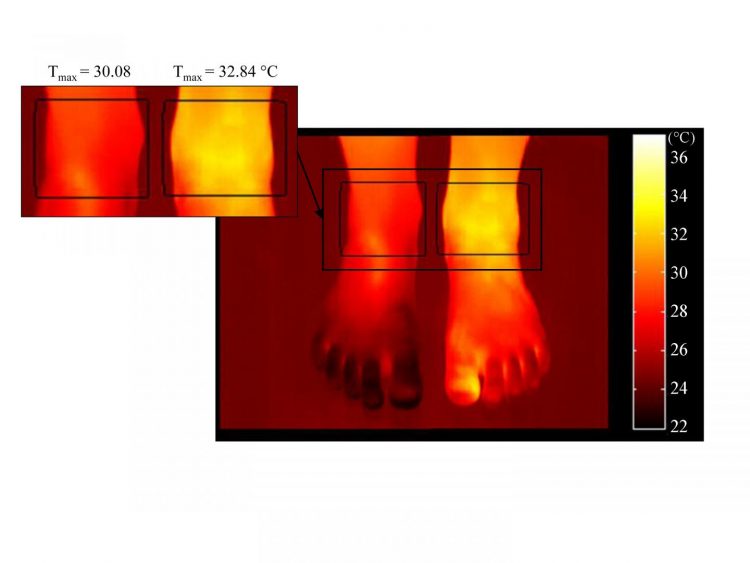Infrared thermography can detect joint inflammation and help improving work ergonomics

An example case of ankle joint inflammation: the maximum skin temperature of the inflamed joint is higher than in the non-inflamed joint. Credit: Roope Lasanen
All objects with a temperature above absolute zero emit infrared radiation as a result of the thermal motion of their molecules. Infrared thermography (IRT) is an imaging modality that can be used to detect this thermal radiation. Human skin emits infrared radiation almost like a perfect black body, and IRT is thus well suited for the measurement of skin temperature.
However, although the human core temperature may be indicative of several bodily dysfunctions, there is still a lack of scientific evidence about which musculoskeletal diseases or conditions can be diagnosed by evaluating skin surface temperature with IRT. Nonetheless, since it is a non-invasive and straightforward technique, IRT may represent a cost-effective alternative to the more traditional imaging modalities.
The study evaluated the capability of IRT to detect inflammation in knee and ankle joints in children, and found that skin surface temperatures were significantly elevated in inflamed ankle joints, but not in inflamed knee joints. This means that IRT can be used as a tool for detecting joint inflammation in ankle joints; however, further research is needed to determine whether IRT can be used to detect inflammation in knee joints.
As healthcare costs are continuously spiralling, there is a clear demand for new diagnostic imaging modalities at the level of basic healthcare. This could ease the workload in specialized healthcare, make diagnostics more accessible and help reduce overall costs.
“In the future, IRT may become a complementary clinical assessment tool, and it can help in therapeutic decision-making,” says researcher Roope Lasanen of the University of Eastern Finland.
Infrared thermography a tool for evaluating work ergonomics
The study also analysed skin temperature in relation to various musculoskeletal conditions. Work ergonomics was evaluated by means of IRT and surface electromyography combined with a subjective assessment conducted by a neck disability index. The study found that IRT demonstrated potential in evaluating office ergonomics and that spatial variation of upper back skin temperature was a promising measure in ergonomic assessments.
Cooling menthol gels – cold on the spot
The study also used IRT to evaluate the effect on skin temperature of the menthol concentration in cold gels commonly used for the treatment of muscle injuries. Although menthol-based cold gels are very widespread, very little is known about how the menthol concentration affects skin temperature. The study found that changes in the menthol concentration did not seem to have any significant effect on skin cooling. Furthermore, cold gels did not have a significant effect on skin temperature in surrounding skin areas adjacent to the gel application site.
###
The findings were originally published in Physiological Measurement, and Skin Research and Technology (in press).
The doctoral dissertation of Roope Lasanen, MSc, entitled Infrared thermography in the evaluation of skin temperature: Applications in musculoskeletal conditions is available for download at http://epublications.
For further information, please contact:
Researcher Roope Lasanen, tel. +358 443666196, roope.lasanen@uef.fi
Media Contact
All latest news from the category: Medical Engineering
The development of medical equipment, products and technical procedures is characterized by high research and development costs in a variety of fields related to the study of human medicine.
innovations-report provides informative and stimulating reports and articles on topics ranging from imaging processes, cell and tissue techniques, optical techniques, implants, orthopedic aids, clinical and medical office equipment, dialysis systems and x-ray/radiation monitoring devices to endoscopy, ultrasound, surgical techniques, and dental materials.
Newest articles

Innovative 3D printed scaffolds offer new hope for bone healing
Researchers at the Institute for Bioengineering of Catalonia have developed novel 3D printed PLA-CaP scaffolds that promote blood vessel formation, ensuring better healing and regeneration of bone tissue. Bone is…

The surprising role of gut infection in Alzheimer’s disease
ASU- and Banner Alzheimer’s Institute-led study implicates link between a common virus and the disease, which travels from the gut to the brain and may be a target for antiviral…

Molecular gardening: New enzymes discovered for protein modification pruning
How deubiquitinases USP53 and USP54 cleave long polyubiquitin chains and how the former is linked to liver disease in children. Deubiquitinases (DUBs) are enzymes used by cells to trim protein…



